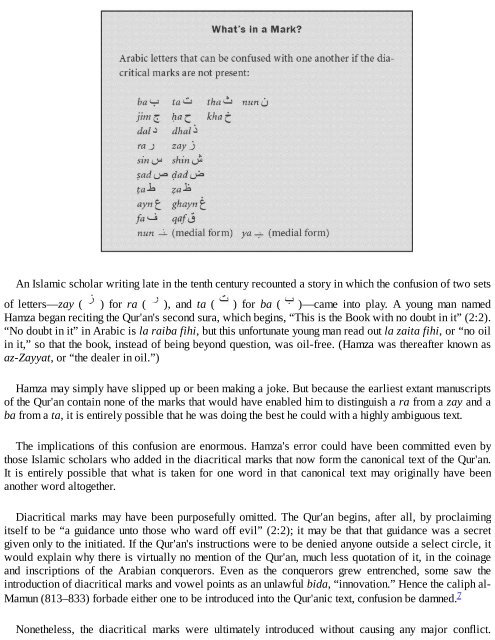robert spencer-did muhammad exist__ an inquiry into islams obscure origins-intercollegiate studies institute (2012) (1)
Create successful ePaper yourself
Turn your PDF publications into a flip-book with our unique Google optimized e-Paper software.
An Islamic scholar writing late in the tenth century recounted a story in which the confusion of two sets<br />
of letters—zay ( ) for ra ( ), <strong>an</strong>d ta ( ) for ba ( )—came <strong>into</strong> play. A young m<strong>an</strong> named<br />
Hamza beg<strong>an</strong> reciting the Qur'<strong>an</strong>'s second sura, which begins, “This is the Book with no doubt in it” (2:2).<br />
“No doubt in it” in Arabic is la raiba fihi, but this unfortunate young m<strong>an</strong> read out la zaita fihi, or “no oil<br />
in it,” so that the book, instead of being beyond question, was oil-free. (Hamza was thereafter known as<br />
az-Zayyat, or “the dealer in oil.”)<br />
Hamza may simply have slipped up or been making a joke. But because the earliest ext<strong>an</strong>t m<strong>an</strong>uscripts<br />
of the Qur'<strong>an</strong> contain none of the marks that would have enabled him to distinguish a ra from a zay <strong>an</strong>d a<br />
ba from a ta, it is entirely possible that he was doing the best he could with a highly ambiguous text.<br />
The implications of this confusion are enormous. Hamza's error could have been committed even by<br />
those Islamic scholars who added in the diacritical marks that now form the c<strong>an</strong>onical text of the Qur'<strong>an</strong>.<br />
It is entirely possible that what is taken for one word in that c<strong>an</strong>onical text may originally have been<br />
<strong>an</strong>other word altogether.<br />
Diacritical marks may have been purposefully omitted. The Qur'<strong>an</strong> begins, after all, by proclaiming<br />
itself to be “a guid<strong>an</strong>ce unto those who ward off evil” (2:2); it may be that that guid<strong>an</strong>ce was a secret<br />
given only to the initiated. If the Qur'<strong>an</strong>'s instructions were to be denied <strong>an</strong>yone outside a select circle, it<br />
would explain why there is virtually no mention of the Qur'<strong>an</strong>, much less quotation of it, in the coinage<br />
<strong>an</strong>d inscriptions of the Arabi<strong>an</strong> conquerors. Even as the conquerors grew entrenched, some saw the<br />
introduction of diacritical marks <strong>an</strong>d vowel points as <strong>an</strong> unlawful bida, “innovation.” Hence the caliph al-<br />
Mamun (813–833) forbade either one to be introduced <strong>into</strong> the Qur'<strong>an</strong>ic text, confusion be damned. 7<br />
Nonetheless, the diacritical marks were ultimately introduced without causing <strong>an</strong>y major conflict.


